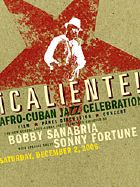
Downtown looked uptown in the New School’s day of Afro-Cuban programming, most explicitly in From Mambo to Hip Hop: a South Bronx Tale, a documentary which examined the impact of music on the borough which the Yankees call home. The film included some interesting interviews with Afro-Cuban jazz artists like Ray Barretto and co-producer Bobby Sanabria. Perhaps most striking were the clear visual similarities between mambo dancers like Tito Rodríguez and later Hip Hop dancers. While there may have been clear stylistic differences, the kinesthetic parallels were obvious.
Some things did seem to change. Returning to Paul Austerlitz’s history of the Machito band in Jazz Consciousness, he writes about Ernest Ensley, one of many mambo dancers who were then on the scene:
“Ensley’s life as a mambero was a true labor of love: he often danced after a full day’s work, returning home as late as 5:30 A.M., only to leave for work again as early as 8:00 or 9:00 A.M.!” (p. 86)
South Bronx Tale celebrates the all-night Hip-Hop parties that grew out of truce among Bronx gangs. Participants talked of partying all night, getting breakfast, and then partying all day. While that might be preferable to open gang warfare, it is essentially hedonism and has little in common with the example of Ensley.
South Bronx Tale does discuss the hits the borough has taken, correctly identifying drugs, gangs, and the South Bronx Expressway, which Robert Moses rammed through the Bronx without regard to the destructive impact on formerly middle class residential communities. I would add the Bronx also suffered under feckless Beame and Dinkins administrations, whose sad records on crime and economic development led normally Democratic New Yorkers to elect Giuliani in 2001. (Koch gets a marginal pass.)
The Q&A afterwards was the usual mixed bag. Reagan left office in 1989, but many in the audience felt compelled to blame his “budget cuts” for the current state of music education. There is no point in explaining to them education in America is almost entirely founded at the state and local level, largely through property taxes. They were simply repeating an article of faith amongst New York liberals.
The concert ended the programming on a high note. New School often puts on shows with students playing with well-known faculty members that are always worth seeing. Some students I have seen play at the New School now have CDs out. The current New School Afro-Cuban Jazz Orchestra under the direction of Sanabria is upholding the tradition nicely.
Special guest artist Sonny Fortune brought soul to “Since I fell for You,” segueing into a beautiful “Stormy Weather.” There were plenty of good workouts, like Tito Puente’s “Ran Kan Kan,” featuring Kaitlin Miller on trumpet (who seemed to have the largest cheering section in attendance). New tunes “D Train” and “El Arche de Sanabria en Moderacion” proved that Afro-Cuban jazz is alive and well. Fortune with MasahiroYamamoto on Soprano created waves of sound on the finale “Manteca” that amazed the audience.
All the students acquitted themselves well, with distinctive solos turned in by Yamamoto on alto, Jeremy Viner on tenor, Andrew Carrico on baritone, Miller and Justin Davis in a great trumpet section, and Cristian Rivera on Congas. As usual, the music had more to say than the talking.